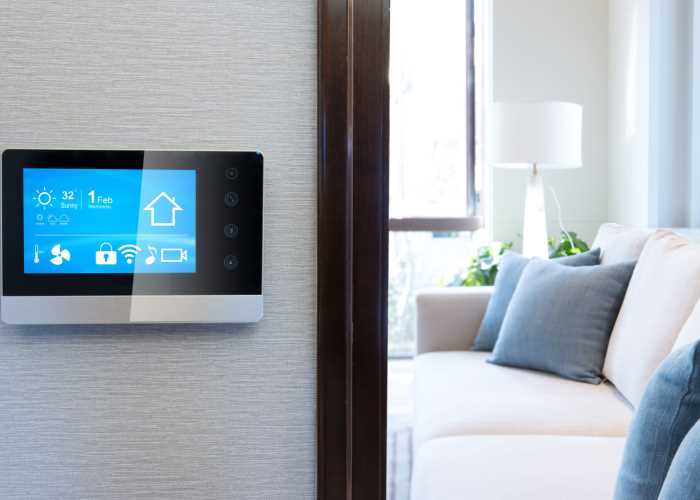A split air conditioning system is an ideal solution for a multi-story home because it offers so much flexibility. When effectively designed and controlled, these systems provide personalised comfort in different areas or zones of the house, as well as catering to the specific cooling needs of each floor.
If you’re looking to install a split system in your property, this guide tells you all you need to know - from understanding your home’s cooling needs to how to set your thermostat once your system is up and running.
Before implementing any cooling strategies, it's important to assess the unique requirements of your home. Several factors contribute to the cooling needs of a multi-story property:

Sunlight exposure: sunlight can heat up a room and make it feel warmer, especially during the peak hours of the day. Rooms that get a lot of sunlight, like those that are south-facing, might need more cooling compared to north-facing rooms, those that are shaded or those that have fewer windows.
Insulation quality: think of insulation as a protective barrier for your home's indoor climate. Good insulation prevents warm air from escaping during colder months, but it also helps trap cool air inside throughout the summer. Insulation quality can vary throughout your home, and areas with poor insulation can make your AC system work harder to maintain a comfortable temperature.
Room usage: different rooms in your home serve distinct purposes and have varying cooling needs. For instance, bedrooms may require cooler temperatures for comfortable sleep while living rooms might benefit from slightly higher temperatures. Kitchens can have significantly higher heat loads and thus demand additional cooling.
Floor plan and airflow: the layout of your home can affect how air circulates and distributes throughout the space. Closed doors or blocked vents can hinder airflow, leading to uneven cooling and potential hotspots.
By taking the time to consider these factors, you can tailor your cooling efforts for each level of your home.
Once you understand the cooling needs of your home, you can begin the design and installation process of your split AC system.
A cooling load calculation takes into account various factors such as the size of your home, the number and size of windows, insulation quality, and the local climate. It helps determine the cooling capacity required to keep your home at a comfortable temperature.
You can seek the assistance of a professional HVAC technician to perform the load calculation for you. This ensures that you select the right-sized AC units, which are neither too large (wasting energy) nor too small (struggling to cool your home).
Based on the load calculation results, select the appropriate capacity of AC units for each floor or zone in your home. Zoning allows you to divide your home into different areas, each with its own unit, providing precise control over cooling.
Consider using high-efficiency AC units to save energy and reduce electricity bills. Inverter-based AC systems are a great option, as they can adjust their cooling output to match the demand, consuming less energy. Again, a professional HVAC technician can advise you on your best options here.
Zoning your split AC system can greatly improve comfort and energy efficiency. By having separate thermostats for different areas, you can set different temperatures for each zone based on usage and occupancy.
For example, you can set the bedrooms to cooler temperatures at night and raise the temperature in common areas during the day when they are less frequently used. Zoning allows you to cater to individual preferences and optimise cooling where it's needed most.
The indoor units of your split AC system should be installed in places that allow for efficient airflow and cooling distribution. High on the walls is generally recommended, as cool air naturally falls and spreads throughout the room.
Avoid placing indoor units directly above electronic appliances or furniture, as they can obstruct the airflow. Additionally, ensure that the indoor units are easily accessible for maintenance and cleaning.
Ceiling fans can work alongside your AC system to enhance overall comfort. They help circulate cool air and create a wind-chill effect, making you feel cooler without significantly reducing the thermostat setting.
In summer, set your ceiling fans to rotate counterclockwise (when looking up at them) to push air down and create a cooling breeze. Remember to turn off fans when leaving a room, as fans cool people, not the room itself.
Once your split AC system is in place and operational, it's essential to set your thermostat correctly for optimal comfort and energy efficiency. Here are some tips on how to do just that:

Set the upper floors' temperature higher: as warm air rises, upper floors tend to be slightly warmer than the ground floor. To achieve better temperature balance throughout the house, set the thermostat a few degrees higher on upper levels. By doing so, you can prevent excessive cooling on the upper floors and promote a more even distribution of cool air across all levels of your home.
Use zoning wisely: if you’ve opted for zone cooling, tailor the temperature settings for each zone based on usage and occupancy patterns. During the day, if certain zones are unoccupied, consider raising their temperatures slightly to save energy. Before bedtime, adjust the temperatures in the bedrooms to create a comfortable sleep environment.
Consider programmable thermostats: programmable or smart thermostats allow you to set temperature schedules according to your daily routine. You can program them to increase the temperature when you're away or asleep, and lower it before you wake up or return home.
Maintain adequate airflow: good airflow is essential for efficient cooling and consistent temperatures throughout your home. Ensure that air vents are open and unblocked, allowing cool air to flow freely, and regularly clean air filters to prevent dust and debris from obstructing the system.
Every home is unique, and it takes knowledge and expertise to design a system that effectively meets the needs of a multi-story property (and its occupants). If you’re looking to have a new system installed, or to upgrade an existing one, we can help.
We have over 20 years experience in the design, installation and maintenance of air conditioning systems, and understand the complexities involved in cooling a multi-story home.
Our team of experts will work closely with you to assess your property’s layout and your individual preferences to recommend the most suitable split AC system for maximum comfort and energy efficiency.
We’re also members of the Government endorsed TrustMark scheme, so you’ll have peace of mind that your home is in safe hands.
